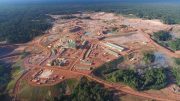The stunning return of the Liberal Party of Canada to majority status in the federal election held Oct. 19 surprised most people in Canada, who had expected at best a surge to minority government from third place behind the ruling Conservative Party of Canada and the New Democratic Party of Canada.
Instead, Canadians woke up to a new political landscape, with voters having taken the middle ground by rebuking the worn-out, pro-big-business Tories but not wanting to roll the dice on the more left-leaning, inexperienced NDP.
Shown the door were the two most recent ministers of natural resources: Conservative Greg Rickford lost his seat in Kenora, Ont., to Liberal Bob Nault, who had a close race with the former provincial NDP leader Howard Hampton; and previous Minister of Natural Resources and current Finance Minister Joe Oliver lost his seat in Toronto. Nault was quick to give some credit for his victory to First Nations communities in the the Kenora region, who mobilized to support him.
Indeed, one theme of the election was the growing political strength shown by aboriginal communities in Canada, with a record 10 indigenous people elected as members of Parliament, up three from 2011, and with a shift to Liberal from Conservative and NDP.
What should miners expect from a Liberal government?
With regard to corporate taxes, the Liberals have pledged to keep them at current levels and retain the 15% flow-through credit for mineral explorers.
Most of the taxation changes will come at the personal level. For example, Canadians with taxable income between $44,700 and $89,400 will see their federal income tax rate fall to 20.5% from 22%, while those making more than $200,000 will see it rise to 33% from 29%.
Perhaps the biggest change that mine developers will see with the new government is the Liberals’ determination to reverse the Conservatives’ streamlining of environmental approvals by skipping the federal approval process, if the project had already met environmental approvals at the provincial level.
The Conservatives saw the two-stage approval process as an expensive and time-consuming duplication of effort, while the Liberals and NDP saw it as necessary oversight, with the federal government not being subject to the more parochial political pressures sometimes applied to provincial regulators.
Another change miners might see is an improved relationship between the federal government and aboriginal communities in Canada, who need to be on-side for many resource development projects to proceed in remote parts of Canada. But it’s hard to generalize on the topic, as relationships can vary from community to community across the country.
The new Liberal government has pledged to allow members of the federal civil service to speak out and attend conferences, in contrast to the much-resented muzzling of federal scientists and related bureaucrats under the Conservative regime. (Here at the Miner, in the early years of the Harper government, we’d repeatedly get federal scientists eagerly offering to write op-ed pieces or serve as expert interviewees, only to have them come back months later frustrated and embarrassed upon learning they were not permitted to talk to us. As the years passed, the emails and phone calls from federal scientists stopped completely.)
It’s hard to see how the Liberals’ pledge for a new round of massive spending on infrastructure will benefit miners (beyond aggregate miners), as most of the plan relates to public transit, social housing and green infrastructure.
Another development we might see is the retabling in a new form of the private member’s bill by then-opposition Liberal MP John McKay (who was just re-elected) to strengthen federal government oversight of the corporate social responsibility activities of Canadian mining companies operating overseas.
In naming a cabinet, we recommend that newly elected Liberal MP Maryann Mihychuk in Winnipeg be considered for Minister of Natural Resources. Mihychuk is a professional geoscientist and businesswoman who served with distinction as Manitoba’s Mines Minister and Minister of Intergovernmental Affairs in the early 2000s. More recently she has been director of regulatory affairs for the Prospectors & Developers Association of Canada, as well as a consultant to mining firms such as Hudbay Minerals and Carlisle Goldfields, among her many mining endeavours.
RELATED STORY: Election 2015: Liberals, Greens and NDP Q&A on mining in Canada



10/10 on IGN
Like skyrim but wth more mines and politics
Would read again